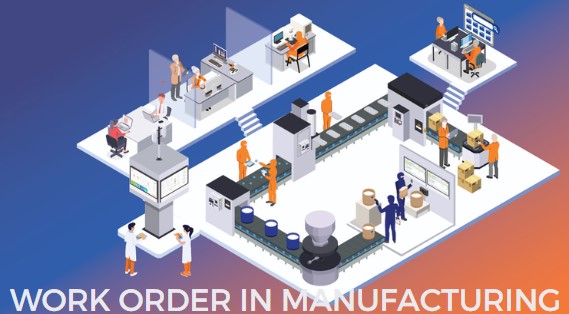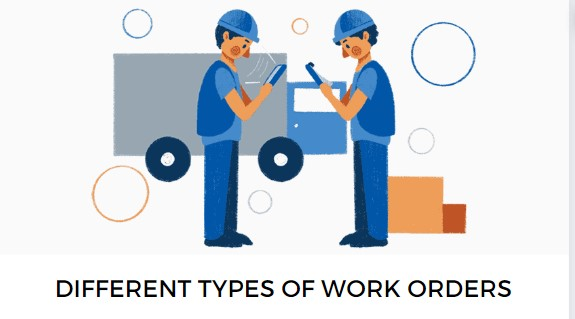
Role of Work Order in Manufacturing
Pratik Lohiya |
12 Apr 2024 |
11:49 AM
- What is a work order in manufacturing?
- Differentiating work order vs. work request
- Understanding Types of Work Orders
- Preventive maintenance work order management software
- General work order
- Inspection work order
- Emergency work order
- Corrective maintenance work orders
- Components of a Comprehensive Work Order
- Benefits of Utilizing Work Order Management Software
- Direct Materials in Work Orders
- Practical Approaches: Handling Work Orders in Manufacturing process
- Templates and Tools: Manufacturing Work Order Template
- Work Orders and Scheduling in Manufacturing
- Advanced Integration: Work Orders and Manufacturing Software
- Future Trends in Work Order Management
- Looking Ahead: The Future of Work Orders in Manufacturing
- Conclusion

5 things to look for in Facility Management Software
Madhurima Sanyal 17 Jun 2024 | 14:04 PMExplore the pivotal role of Facilities Management Software (FMS) in modern business operations and how it optimizes facility functioning. Uncover insights on selecting the ideal FMS for efficient maintenance management and enhanced productivity. Empow...
In the intricate ecosystem of manufacturing, efficiency, precision, and coordination are paramount. At the heart of this operational symphony lies the work order—a pivotal document that orchestrates the seamless execution of tasks within a production line. But what exactly is a work order in manufacturing, and how does it differ from a mere work request?
What is a work order in manufacturing?
A work order in manufacturing serves as a directive, delineating specific tasks, timelines, and resources required to complete a designated job within the production process. It acts as a guiding beacon for personnel on the shop floor, outlining their duties and responsibilities with clarity and precision.
Differentiating work order vs. work request
Distinguishing a work order from a work request is crucial. While a work request may initiate the process by identifying a need for maintenance, repair, or production, a work order formalizes this request into actionable instructions. Think of it as the difference between raising a hand to signal an issue and receiving a detailed roadmap to address it effectively.
The distinction lies in the level of detail and formality. A work request might be a verbal or written notification of a problem or task, whereas a work order is a structured document that includes comprehensive information such as the nature of the task, material needed, deadlines, and any relevant safety protocols.
Work orders in manufacturing are typically generated within a centralized system or through specialized work order management software. These systems streamline the entire process, from the initial request to the execution and completion of tasks, ensuring optimal efficiency and accountability. A work order in manufacturing acts as a pillar, connecting various elements of the production process—from raw materials to quality control measures—and guiding them toward a common goal: the seamless operation of the production line. It embodies the meticulous planning and coordination required to maintain productivity and uphold quality standards in today's dynamic manufacturing environment.
Understanding Types of Work Orders
In the dynamic landscape of manufacturing, where efficiency and productivity are paramount, different types of work orders serve distinct purposes in ensuring smooth operations and maintaining equipment integrity.

Preventive maintenance work order management software
Preventive maintenance is the cornerstone of proactive equipment management. These work orders are scheduled at regular intervals to perform routine inspections, lubrications, adjustments, and replacements to prevent potential breakdowns and prolong the lifespan of machinery. By addressing issues before they escalate, preventive maintenance work orders help minimize unplanned downtime and optimize equipment performance.
General work order
General work orders encompass a broad spectrum of tasks that don't fall under preventive maintenance or specific repair categories. These can include routine cleaning, minor repairs, or adjustments to equipment settings. General work orders are typically initiated in response to operational needs identified during routine inspections or through work requests submitted by personnel on the shop floor.
Inspection work order
Inspection work orders are dedicated to assessing the condition and performance of equipment or facilities. They involve thorough examinations to identify potential defects, safety hazards, or compliance issues. Inspection work orders play a crucial role in maintaining quality standards, ensuring regulatory compliance, and mitigating risks associated with equipment failure or malfunction.
Emergency work order
Emergencies can strike unexpectedly in manufacturing environments, requiring immediate attention to prevent disruptions or safety hazards. Emergency work orders address critical issues that pose imminent threats to production processes, personnel safety, or facility integrity. These may include equipment breakdowns, power outages, or environmental hazards that demand swift and decisive action to resolve.
Corrective maintenance work orders

Corrective maintenance work orders are initiated in response to identified equipment failures or malfunctions. Unlike preventive maintenance, which aims to prevent issues before they occur, corrective maintenance focuses on rectifying existing problems to restore equipment functionality and minimize production disruptions. These work orders often involve troubleshooting, diagnostics, and repair activities to address the root cause of equipment failures.
By understanding the different types of work orders and their respective roles, manufacturing facilities can effectively manage maintenance activities, optimize equipment performance, and uphold productivity standards. Each type of work order plays a crucial role in the holistic maintenance strategy of modern manufacturing environments, contributing to operational efficiency, equipment reliability, and overall business success.
Components of a Comprehensive Work Order
What should be included in a work order?
A well-crafted work order serves as a roadmap for efficient task execution within a manufacturing environment. To ensure clarity, accountability, and effectiveness, several key components should be included in a comprehensive work order:
Description of Task: Clearly state the nature of the task or maintenance activity to be performed, including any specific instructions or requirements.
Materials Needed: List the materials, parts, or tools required to complete the task, ensuring that personnel have access to all necessary resources.
Scheduled Date and Time: Specify the scheduled date and time for task execution to facilitate planning and coordination on the shop floor.
Priority Level: Indicate the priority level of the work order to prioritize tasks based on urgency and impact on production.
Safety Precautions: Include any relevant safety protocols or precautions to ensure the well-being of personnel and prevent accidents or injuries.
Instructions and Notes: Provide any additional instructions, notes, or special considerations relevant to the task to guide personnel effectively.
By including these components in a work order, manufacturing facilities can streamline operations, enhance communication, and uphold quality control standards throughout the production process.
Benefits of Utilizing Work Order Management Software
In the fast-paced realm of manufacturing, where precision and efficiency are paramount, the adoption of advanced technology can be a game-changer. Work order management software emerges as a powerful tool, offering a plethora of benefits that streamline operations and enhance overall productivity.
Improving communication
Effective communication is the lifeblood of any successful manufacturing process. Work order management software provides a centralized system where stakeholders can collaborate seamlessly, exchanging critical information, updates, and instructions in real-time. This ensures that everyone involved in the production process remains aligned, informed, and empowered to make timely decisions.
Maximizing efficiency
Time is of the essence in manufacturing, and every minute saved translates to increased productivity and profitability. Work order management system optimizes workflow by automating repetitive tasks, streamlining processes, and eliminating manual inefficiencies. By digitizing work orders and automating scheduling, assignment, and notification processes, manufacturers can maximize operational efficiency and minimize downtime.
Tracking progress
Transparent visibility into the status and progress of work orders is essential for effective decision-making and resource allocation. Work order management software offers real-time tracking capabilities, allowing managers to monitor the status of tasks, track resource utilization, and identify potential bottlenecks or delays. This real-time insight enables proactive intervention, ensuring that projects stay on track and deadlines are met.
Improving quality
Quality control is non-negotiable in manufacturing, where even minor defects can have significant repercussions. Work order management software facilitates adherence to quality standards by standardizing processes, enforcing compliance with protocols, and facilitating rigorous inspection and testing procedures. By maintaining consistency and accuracy throughout the production process, manufacturers can deliver products that meet or exceed customer expectations.
Reducing costs
Cost optimization is a perpetual pursuit in manufacturing, and work order management process plays a pivotal role in achieving this objective. By streamlining processes, minimizing waste, and maximizing resource utilization, manufacturers can reduce operational costs and enhance profitability. Additionally, proactive maintenance scheduling facilitated by the software helps prevent costly equipment breakdowns and prolong asset lifespan, further contributing to cost reduction efforts.

The adoption of work order management software revolutionizes manufacturing operations by enhancing communication, maximizing efficiency, tracking progress, improving quality, and reducing costs. By harnessing the power of technology, manufacturers can navigate the complexities of the modern manufacturing landscape with confidence, agility, and unparalleled success.
Direct Materials in Work Orders
Importance of direct materials in manufacturing work orders
Direct materials are the lifeblood of manufacturing, serving as the essential components required to transform raw inputs into finished products on the production line. In the context of work orders, direct materials play a pivotal role in ensuring task completion and product quality.
The importance of direct materials in manufacturing work orders cannot be overstated. These materials, such as components, parts, and raw materials, are explicitly listed in work orders to provide clear guidance to personnel responsible for task execution. By specifying the direct materials needed for each task, work orders facilitate efficient resource allocation, minimize delays, and prevent errors or omissions during the production process.
Moreover, direct materials directly impact product quality and performance. Ensuring the availability and quality of direct materials specified in work orders is essential for meeting production standards, customer expectations, and regulatory requirements. By incorporating direct materials into work orders, manufacturers can uphold consistency, precision, and excellence in their manufacturing operations.
Practical Approaches: Handling Work Orders in Manufacturing process
Effectively managing work orders is essential for optimizing productivity and maintaining operational efficiency in manufacturing environments. Here are some practical approaches to handling work orders effectively:
How to effectively handle work orders in manufacturing
-
Streamline Communication: Establish clear channels of communication to ensure that work orders are communicated promptly and accurately to relevant personnel. Utilize work order management software or systems to centralize communication and facilitate real-time updates and notifications.
-
Prioritize Work Orders: Prioritize work orders based on urgency, impact on production, and resource availability. Assign priority levels to tasks to ensure that critical issues are addressed promptly while effectively managing resources and manpower.
-
Assign Responsibilities Clearly: Clearly define roles and responsibilities for each work order to avoid confusion and ensure accountability. Assign tasks to specific individuals or teams based on their expertise and availability, ensuring that everyone understands their role in the execution process.
-
Track Progress Continuously: Implement robust tracking mechanisms to monitor the progress of work orders in real time. Use work order management software to track task completion, resource utilization, and any deviations from the planned schedule. Regularly review progress reports to identify potential bottlenecks and take corrective actions promptly.
-
Manage Expenses Effectively: Track expenses associated with work orders to monitor costs and maintain budgetary control. Capture and record all expenditures, including materials, labor, and external services, to ensure accurate cost tracking and analysis. This helps in identifying cost-saving opportunities and optimizing resource allocation in future work orders.
-
Implement Continuous Improvement: Continuously evaluate and refine work order processes based on feedback, performance data, and lessons learned. Identify areas for improvement and implement corrective actions to enhance efficiency, quality, and cost-effectiveness in handling work orders.
By implementing these practical approaches, manufacturing facilities can effectively handle work orders, streamline operations, and drive continuous improvement across the production line. Efficient work order management system is crucial for achieving operational excellence and maintaining competitiveness in today's dynamic manufacturing landscape.
Templates and Tools: Manufacturing Work Order Template
Utilizing a manufacturing work order template for efficient management
In the fast-paced environment of manufacturing, efficiency and organization are key to success. Utilizing a manufacturing work order template can streamline operations and enhance overall management efficiency.
A manufacturing work order template serves as a standardized framework for documenting and executing tasks within the production process. It typically includes essential information such as task descriptions, required materials, scheduled dates, assigned personnel, and priority levels. By providing a structured format, the template ensures consistency and clarity across all work orders, facilitating effective communication and minimizing errors or omissions.
Moreover, utilizing a manufacturing work order template simplifies the process of creating and managing work orders, saving time and effort for personnel involved in task execution. With predefined fields and formats, the template eliminates the need to create work orders from scratch, allowing personnel to focus on task execution rather than administrative tasks.
Additionally, the template can be customized to suit the specific requirements of different tasks, departments, or production lines, ensuring flexibility and adaptability to changing needs. By leveraging the benefits of a manufacturing work order template, organizations can enhance efficiency, accuracy, and productivity in managing their production processes.
Work Orders and Scheduling in Manufacturing
Importance of scheduling in work order management
Effective scheduling is the linchpin of successful work order management in manufacturing. It ensures that tasks are executed in a timely manner, resources are allocated efficiently, and production goals are met. Let's delve into the importance of scheduling in work order management and the integration of work orders with scheduling processes:
Scheduling plays a vital role in optimizing production processes by ensuring that tasks are sequenced logically and assigned to the right personnel based on their availability and skillsets. It helps in balancing workload across the production line, preventing bottlenecks, and minimizing idle time.
Integrating work orders with scheduling processes
Integration of work orders with scheduling processes streamlines operations and enhances efficiency. By aligning work orders with the production schedule, manufacturers can prioritize tasks, allocate resources effectively, and meet production deadlines with precision.
Furthermore, integrating work orders with scheduling processes enables real-time tracking of task progress and resource utilization. This visibility allows managers to make informed decisions, adjust schedules as needed, and respond promptly to changes or unexpected events on the shop floor.
In essence, scheduling is a cornerstone of effective work order management in manufacturing, ensuring seamless coordination, optimal resource utilization, and timely execution of tasks to drive productivity and meet customer demands. Integrating work orders with scheduling processes enhances operational agility, facilitates proactive decision-making, and fosters continuous improvement across the production line.
Advanced Integration: Work Orders and Manufacturing Software
Integrating work orders with manufacturing software for seamless operations
In today's digital era, integrating work orders with manufacturing software is a game-changer for optimizing operations and enhancing efficiency. This advanced integration brings together the power of work order management and manufacturing software to streamline processes, improve visibility, and drive productivity.
By integrating work orders with manufacturing software, manufacturers can achieve seamless operations across the production line. Work orders are seamlessly generated within the manufacturing software based on production requirements, allowing for efficient allocation of resources and scheduling of tasks.
Moreover, this integration enables real-time tracking of work orders and production progress. Managers have instant access to critical data, such as task status, resource utilization, and production metrics, empowering them to make informed decisions and respond promptly to changes or challenges on the shop floor.
Furthermore, integrating work orders with manufacturing software facilitates automation of repetitive tasks, reducing manual effort and minimizing the risk of errors or delays. This automation enhances operational efficiency, accelerates throughput, and improves overall production performance.
Future Trends in Work Order Management
Automation and Artificial Intelligence in work order management
Automation and AI technologies are revolutionizing work order management by automating repetitive tasks, optimizing resource allocation, and enabling predictive analytics. AI algorithms can analyze historical data to identify patterns, predict equipment failures, and recommend preventive maintenance actions, helping manufacturers adopt proactive maintenance strategies and minimize downtime.
Predictive Maintenance for proactive maintenance strategies
Predictive maintenance is gaining traction as a proactive approach to equipment maintenance. By leveraging sensors, IoT devices, and machine learning algorithms, manufacturers can predict potential equipment failures before they occur, allowing for timely intervention and maintenance. This not only reduces unplanned downtime but also extends the lifespan of assets and improves overall equipment reliability.
Augmented Reality (AR) and Virtual Reality (VR) applications
AR and VR technologies are revolutionizing training, troubleshooting, and maintenance tasks in manufacturing. With AR-enabled smart glasses or VR headsets, technicians can access digital overlays of equipment manuals, visual guides, and step-by-step instructions, enhancing their productivity and accuracy in completing work orders.
Mobile Work Order Management for on-the-go accessibility
Mobile work order management solutions enable technicians to access, update, and complete work orders on-the-go using smartphones or tablets. This enhances flexibility, responsiveness, and real-time collaboration among field personnel, allowing them to efficiently execute tasks regardless of their location.
Cloud-Based Work Order Management Systems for scalability and flexibility
Cloud-based work order management systems offer scalability, flexibility, and accessibility. By storing data in the cloud, manufacturers can access work orders from any location, collaborate in real-time, and scale their operations seamlessly as their business grows. Cloud-based systems also offer enhanced security, automatic updates, and cost-effectiveness compared to traditional on-premise solutions.
The future of work order management in manufacturing is marked by automation, predictive maintenance, AR/VR applications, mobile accessibility, and cloud-based solutions. Embracing these trends allows manufacturers to stay ahead of the curve, optimize their operations, and drive continuous improvement in work order management processes. By harnessing the power of technology and innovation, manufacturers can unlock new levels of efficiency, productivity, and competitiveness in the dynamic manufacturing landscape of tomorrow.
Looking Ahead: The Future of Work Orders in Manufacturing
The future of work order management in manufacturing is poised for transformation, driven by emerging trends and innovations that promise to revolutionize the way tasks are planned, executed, and monitored. Let's explore some of the key trends shaping the future of work orders in manufacturing:
Emerging trends and innovations shaping the future of work order management in manufacturing
-
Automation and Digitization: Automation and digitization are reshaping work order management processes, enabling manufacturers to streamline operations, reduce manual effort, and enhance efficiency. Advanced technologies such as robotic process automation (RPA) and digital twins are automating repetitive tasks, optimizing resource utilization, and providing real-time insights into production processes.
-
Predictive Maintenance: Predictive maintenance is becoming increasingly prevalent in manufacturing, allowing organizations to predict and prevent equipment failures before they occur. By leveraging data analytics, IoT sensors, and machine learning algorithms, manufacturers can identify potential issues, schedule maintenance proactively, and avoid costly downtime, thus optimizing asset performance and reliability.
-
Integration with IoT and Connectivity: The Internet of Things (IoT) is revolutionizing work order management by enabling connectivity between equipment, sensors, and systems. IoT-enabled devices can capture real-time data on equipment performance, environmental conditions, and production metrics, empowering manufacturers to make data-driven decisions, optimize processes, and improve overall efficiency.
-
Enhanced Collaboration and Communication: Collaboration tools and communication platforms are facilitating seamless collaboration among stakeholders involved in work order management. Integrated systems enable real-time communication, task assignment, and progress tracking, fostering collaboration across departments, teams, and locations.
-
AI-driven Insights: Artificial intelligence (AI) and machine learning technologies are providing valuable insights into work order management processes. AI algorithms can analyze vast amounts of data to identify patterns, trends, and anomalies, enabling manufacturers to make informed decisions, optimize workflows, and improve productivity.
-
Enhanced Mobility: Mobile technologies are empowering field technicians and personnel to access, update, and complete work orders on-the-go. Mobile applications provide instant access to work order information, task instructions, and equipment manuals, enabling technicians to perform tasks efficiently and accurately, regardless of their location.
The future of work orders in manufacturing is characterized by automation, digitization, predictive maintenance, IoT integration, enhanced collaboration, AI-driven insights, and mobile accessibility. By embracing these trends and leveraging advanced technologies, manufacturers can streamline operations, enhance efficiency, and remain competitive in an increasingly dynamic and demanding marketplace. The future holds immense promise for work order management, with innovations driving continuous improvement and innovation across the manufacturing sector.
Conclusion
The role of work orders in manufacturing is not merely administrative but pivotal in ensuring smooth, efficient, and optimized operations across the production line. As the manufacturing landscape continues to evolve, it is evident that work order management is undergoing significant transformation, driven by emerging trends, technological advancements, and evolving industry practices.
Throughout this exploration, we have delved into various aspects of work order management, from understanding the fundamentals of work orders to exploring their integration with advanced manufacturing software and future trends shaping the industry. Work orders serve as the backbone of manufacturing operations, providing a structured framework for planning, executing, and tracking tasks, resources, and timelines.
One of the critical aspects highlighted is the importance of preventive maintenance and predictive maintenance strategies in work order management. By adopting proactive maintenance approaches, manufacturers can minimize equipment downtime, optimize asset performance, and reduce maintenance costs, ultimately enhancing overall operational efficiency and asset reliability.
Furthermore, the integration of work orders with advanced technologies such as automation, artificial intelligence, and IoT is driving unprecedented levels of efficiency, productivity, and innovation in manufacturing. These technologies enable real-time monitoring, data-driven decision-making, and predictive analytics, empowering manufacturers to optimize processes, mitigate risks, and capitalize on opportunities for continuous improvement.
The future of work orders in manufacturing is bright, with emerging trends such as enhanced mobility, augmented reality, and cloud-based solutions promising to revolutionize how work orders are created, managed, and executed. These advancements not only enhance accessibility and collaboration but also pave the way for greater agility, scalability, and adaptability in manufacturing operations.
In essence, work order management is undergoing a paradigm shift, evolving from traditional, paper-based processes to digital, automated systems that offer real-time visibility, predictive insights, and seamless integration with other manufacturing systems. Manufacturers must embrace these changes, invest in technology, and foster a culture of innovation to stay competitive and meet the demands of an ever-evolving market.
As we look ahead, it is clear that work orders will continue to play a vital role in driving operational excellence, customer satisfaction, and business success in manufacturing. By leveraging the power of technology, embracing emerging trends, and prioritizing continuous improvement, manufacturers can unlock new levels of efficiency, productivity, and profitability in the dynamic and challenging landscape of modern manufacturing. Work orders are not just documents; they are the blueprint for success in the manufacturing industry of tomorrow.